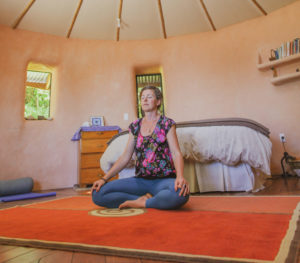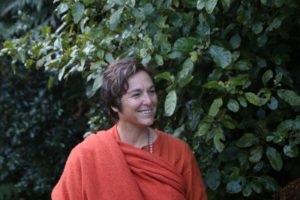
The Yoga of Self-Enquiry. Exploring Strengths, Weaknesses, Aims & Needs.
By Swami Karma Karuna
This article explores Jnana yoga -the process of sincere self-enquiry with the aim of finding true inner wisdom. The mind is used to question into its own nature, and to go beyond the illusions and identification with thoughts and ego. Jnana Yoga is closely linked with the process of meditation and particularly the development of mindfulness or witness awareness, which is used to reflect back on our actions and thoughts with the aim of gaining deeper self-understanding.
Learning to witness and become the observer is also inherent in two important yogic principles which allow us to understand ourselves more deeply.
Viveka:
The right discrimination in order to know what is conducive and what is destructive for our own expansion. In viveka one enquires with total sincerity, learning to discriminate between the self and the non-self, between the permanent and the impermanent. A person full of viveka asks questions not to satisfy the mind, but rather from an incomplete heart searching for completeness.

Vairagya:
A sense of non-attachment to the objects, people and experiences that create pain or pleasure in life. This is not to be misunderstood as irresponsibility and inability to connect or love, but rather is a quality based on interacting with life fully, but without the attachment to it. In the same way that a banker is not attached to the money that goes through her hands each day, because it does not belong to her personally, one has to live life fully but release the idea of ownership and identification with the objects and people. Without vairagya, we cannot go beyond the deep mental patterns. In the Bhagavad-Gita, vairagya is described as a sharp instrument needed to cut through the attachments.
SWAN Technique:
With the tools of witness, viveka and vairagya, one can really begin to explore themselves. The self-enquiry and self-analysis tool called SWAN practice, developed by Swami Niranjan, is an acronym for Strengths, Weaknesses, Ambitions and Needs. Through deeply reflecting on each of these aspects over time, we come to know and understand ourselves objectively. SWAN takes us on a journey of self-exploration, allowing us to examine our own nature, to accept ourselves for the person that we are without judgement, and to work towards transformation.

SWAN sadhana is a way to realise our dormant potential. If we do not accept ourselves, we create disharmony. When we attain self-acceptance, we can transform weaknesses into strengths and give energy to manifesting dormant strengths. Over time, we learn to decipher what we really need as compared to what we want. We can also redirect our ambitions in positive ways, so that they are expressed in a way that enhances our spiritual development.
Often, we perceive that it is a situation or person that blocks us, but when we look deeply into the mind, we see that we block ourselves. In the process of re-programming the mind, the ego will try to stop us by grasping onto its power or perhaps creating needs and desires. These needs and desires stem from the lower chakras and patterns and traumas often created in childhood e.g. in Mooladhara there may be insecurities that create needs, in Swadisthana many desires and ambitions can arise and in Manipura the driving force to fulfill ambitions.
It is important that the ego expresses itself in a natural way to avoid creating mental imbalance. The process of SWAN gives us the clarity within ourselves to express the best qualities, transform weaknesses, direct ambitions with awareness and honour the real needs.

A brief description of each of the aspects of SWAN is detailed below:
- Strengths are those positive attributes that we are born with, or that we acquire, that help us to evolve (faith, persistence, physical strength, a caring nature, knowledge, patience etc.)
- Weaknesses are the traits in our personality that hinder our progress (laziness, jealousy, hatred, possessiveness, greediness, anger and procrastination etc.)
- Aims or Ambitions are the desires that drive us to accomplish our goals so that we feel fulfilled (money, power, praise, fame; transformation, service etc.)
- Needs are food, a home, love, friends, health etc. Needing something is different from wanting something. Needs help you to create your ambitions.
The four aspects above can be broken down into four categories: physical, mental, emotional and spiritual. For example:
- Physical needs include the basic survival; food, water, clothing and shelter as well as financial stability.
- Mental needs involve the desire for satisfaction and a purpose in life.
- Emotional needs include pleasure, companionship, sexuality, sensual and emotional satisfaction.
- Spiritual needs comprise a yearning for inner harmony and balance with nature.
SWAN sadhana can be a meditation, a written exercise, a daily practice, and a way to make decisions, consider relationships, jobs etc. It can also help one to set focus on the sankalpa or positive intention.
Set aside ten to fifteen minutes at the end of each day to do your SWAN practice. Write down your strengths and weaknesses. Do not rush this process – your strengths and weaknesses will come to you over a period of time. Be totally honest with yourself without judgement.
Next, list your ambitions. What do you want to achieve? What do you aspire towards? Write anything that comes into your mind. Then, write down your needs – not necessarily what you want but what you need. Self-compassion is very important in this process.

After some time observe which characteristics appear more often, or may be situational, and evaluate yourself. There might be ten or twenty strengths for one month, but some of them may only appear on your list once while others may appear again and again. Find three or four common strengths, weaknesses, aims and needs and compile them into one list.
You may like to choose one weakness that you want to transform or let go of over the next month. Be mindful of that weakness for the whole month and use your strengths to rise above and overcome or throw out that weakness. Or choose one strength to develop. Remind yourself daily, analyse how or when you use it or block it etc.
Look at your ambitions and analyse what steps you need to take to manifest them? Do you need to alter your sankalpa or positive resolution to fit in with your ambitions? Over the month observe which needs you can successfully drop or put into the ambitions list, and which ones you in some way do not give attention to, and adjust your needs list.
Through this process of self-analysis, you begin to act differently in your world and your self-images change. You begin to see that what is often portrayed is momentary or repeated patterns, not the real nature, and you can learn to dis-identify with that which does not serve your higher purpose. Everything is in a constant state of change and is, therefore, impermanent. Observing this becomes exciting and inspiring, and makes it possible for true transformation to occur.
Using SWAN is an important tool to understand the self, draw out the richness within and gradually release that which is no longer necessary. After practising for a while you will come to know that what you need for a certain situation or relationship is within you – you just have to tap into it and then life becomes very positive. You gradually learn to know your inner self.

Swami Karma Karuna is a director of Anahata Yoga Retreat, New Zealand, a certified yoga therapist through International Association of Yoga Therapists, IYTA member and Senior Yoga Australia Teacher. She has more than 25 years of training and teaching experience, including Yoga Nidra Instructors Trainings, India meditation and yoga retreats, international events and one to one guidance.
